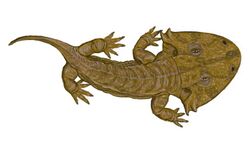Biology:Acanthostomatops
| Acanthostomatops | |
|---|---|

| |
| Restoration of Acanthostomatops vorax | |
| Scientific classification Error creating thumbnail: Unable to save thumbnail to destination
| |
| Domain: | Eukaryota |
| Kingdom: | Animalia |
| Phylum: | Chordata |
| Class: | Amphibia |
| Order: | †Temnospondyli |
| Family: | †Zatracheidae |
| Genus: | †Acanthostomatops Kuhn, 1961 |
| Type species | |
| †Acanthostoma vorax Credner, 1883
| |
| Synonyms | |
|
Melanerpeton spiniceps | |
Acanthostomatops is an extinct genus of zatracheidid temnospondyl from the Lower Permian Döhlen Basin of Saxony.
History of study
Acanthostomatops was originally named as the type species Acanthostoma vorax, in 1883.[1] However, the genus name Acanthostoma was previously used for a polychaete worm back in 1813, and the present name was given in 1961.[2] Detailed descriptions of the taxon were given by Steen & Brough (1937),[3] with an emphasis on the ontogeny of the taxon based on the large sample size given by Boy (1989)[4] and Witzmann & Schoch (2006).[5] Werneburg (1998) described a larval specimen of A. vorax,[6] but this was later proven to be a specimen of the micromelerpetid Branchierpeton amblystomum.[5]
Anatomy
Acanthostomatops is diagnosed by six features: (1) lacrimal and prefrontal projecting into orbital; (2) quadratojugal with two lateral spikes; (3) choana laterally constricted by palatal tusk sockets; (4) small, rectangular interclavicle; (5) large and robust humerus present in larval stages; (6) 21-22 presacral vertebrae positions.[7] Compared to the other zatracheidids, it has the proportionately widest skull and the smallest internarial fontanelle, which only slightly divides the nasals. it also lacks posteriorly extensive tabular horns and postparietal horns. It is also the only zatracheidid with definitively known postcranial material.
Development
Over 30 specimens of A. vorax are known from the type locality near Dresden. The ontogenetic changes have been described in detail most recently by Witzmann & Schoch (2006). Among the changes that occur are a proportional shortening of the femur and the trunk relative to the skull and a distinct remodeling of the hyobranchial apparatus, with resorption of the larval form's ceratobranchials and the formation of a complex apparatus of hypobranchials that the authors suggested was for supporting the tongue. Based on the changes to the skeleton and the distribution of size classes within the locality, Witzmann & Schoch (2006) suggested that A. vorax had a biphasic life history, with an aquatic larval to juvenile form and a terrestrial adult form.
References
- ↑ Credner, C. Hermann (1883). "Die Stegocephalen aus dem Rothliegenden des Plauen'schen Grundes bei Dresden. 4. Theil.". Zeitschrift der Deutschen Geologischen Gesellschaft 34: 275–300.
- ↑ Kuhn, Oskar (1961). Die Familien der rezenten und fossilen Amphibien und Reptilien. Bamberg: Meisenbach. pp. 1–79.
- ↑ Steen, Margaret C.; Brough, Mrs. James (September 1937). "On Acanthostoma vorax Credner." (in en). Proceedings of the Zoological Society of London B107 (3): 491–500. doi:10.1111/j.1469-7998.1937.tb00020.x.
- ↑ Boy, Jürgen A. (1989). "Über einige Vertreter der Eryopoidea (Amphibia: Temnospondyli) aus dem europäischen Rotliegend (?höchstes Oberkarbon — Perm)2. Acanthostomatops". Paläontologische Zeitschrift 63 (1–2): 133–151. doi:10.1007/bf02989530. ISSN 0031-0220.
- ↑ 5.0 5.1 Witzmann, F.; Schoch, R. R. (2006). "Skeletal development of the temnospondyl Acanthostomatops vorax from the Lower Permian Döhlen Basin of Saxony". Transactions of the Royal Society of Edinburgh: Earth Sciences 96 (4): 365–385. doi:10.1017/S0263593300001358.
- ↑ Werneburg, Ralf (1998). "Ein larvaler Acanthostomatops (Zatrachydidae, Amphibia) aus der Niederhäslich-Formation (Unter-Perm) des Döhlen-Beckens". Veröffentlichungen des Museums für Naturkunde Chemnitz 21: 49–52.
- ↑ Schoch, Rainer R.; Milner, Andrew R. (2014). Sues, Hans-Dieter. ed. Handbuch der Palaeoherpetologie. Munchen: Verlag Dr. Friedrich Pfeil.
Wikidata ☰ Q4672050 entry
 |

